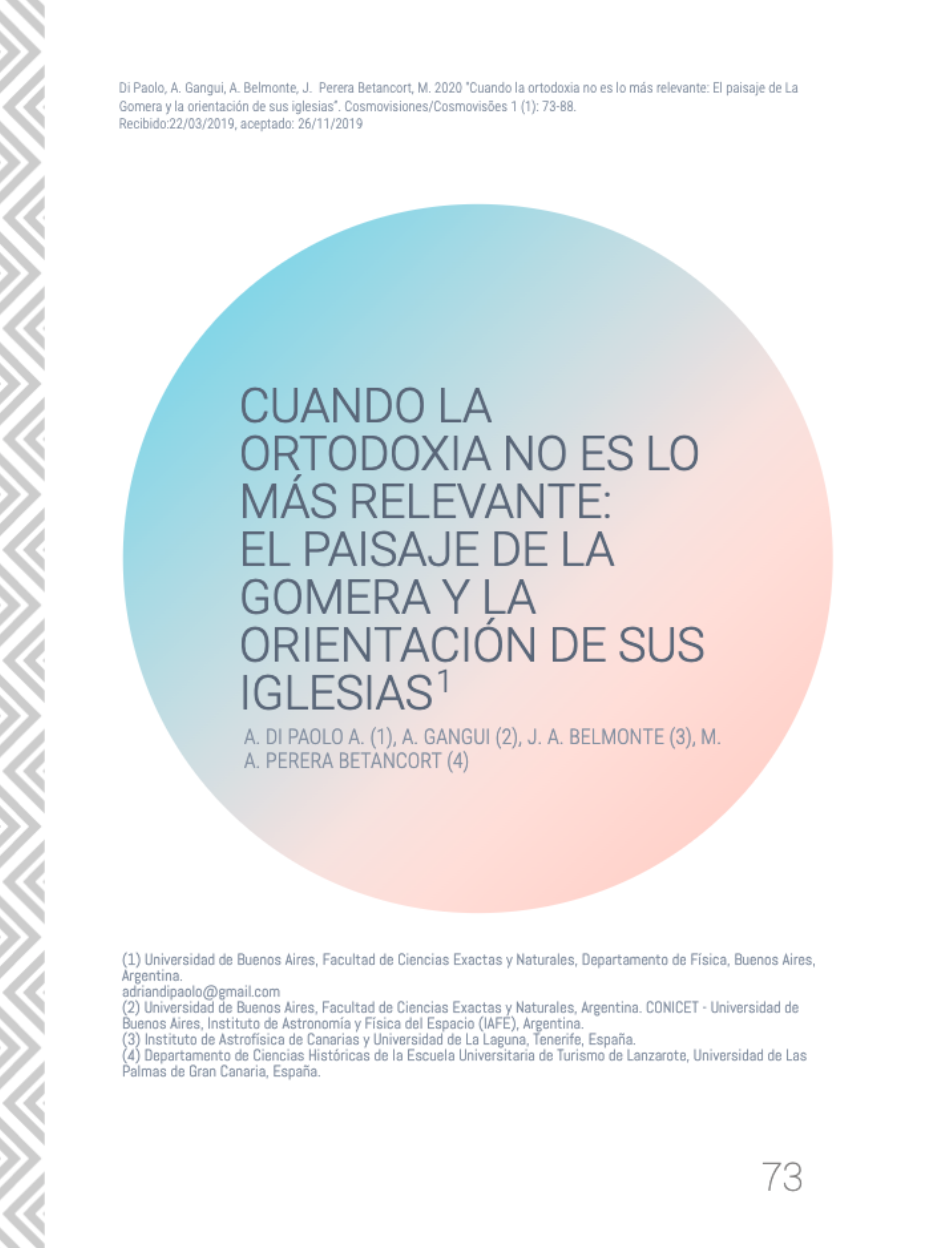Quando a ortodoxia não é a mais relevante: a paisagem de La Gomera e a orientação de suas igrejas
Palavras-chave:
La Gomera, Igrejas, Arqueoastronomia, OrografiaResumo
Apresentamos um estudo da relação entre astronomia e paisagem focado na orientação de igrejas e ermidas cristãs na ilha de La Gomera, localizada no arquipélago das Canárias (Espanha). O trabalho de campo consistiu em medir as coordenadas exatas de localização de 38 igrejas e ermidas, o que representa quase todas as construções religiosas da ilha, que tem uma área de aproximadamente 370 km². Para cada igreja, também foram medidos o azimute e a altura angular do horizonte, tomadas na direção para a qual aponta o altar de cada templo. Os dados assim medidos foram então corroborados com modelos digitais de terreno frequentemente usados em estudos arqueoastronômicos. Por fim, para o estudo da amostra, foram realizadas várias análises: estatísticas, calendáricas e orográficas, tentando encontrar pistas que nos permitissem compreender o padrão de orientações encontrado. A partir desta análise, podemos afirmar que em alguns lugares da ilha foi respeitada a tradição canônica de orientar os templos cristãos dentro da faixa de amplitude do movimento solar. [...]
Downloads
Referências
Álvarez Delgado J. 1960 “Primera conquista y cristianización de Las Islas Canarias. Algunos problemas históricos”. Anuario de Estudios Atlánticos, Madrid, Las Palmas, VI: 445- 492.
Aznar Vallejo E. 1986 “La colonización de las Islas Canarias en el siglo XV”. En la España Medieval, T. V. En memoria de Claudio Sánchez Albornoz. Editorial de la Universidad Complutense de Madrid, I: 195-218.
Belmonte J. A., Esteban C., Aparicio A., Tejera Gaspar A. y González O. 1994 “Canarian Astronomy before the conquest: the pre-hispanic calendar”. Rev. Acad. Can. Ciencias, VI (2-3-4): 133-156.
Darías Príncipe A. 1992 La Gomera: espacio, tiempo y forma. Compañía Mercantil Hispano-Noruega, Santa Cruz de Tenerife.
Díaz Padilla G. 2005 “La evolución parroquial de La Gomera y el patrimonio documental generado por la institución eclesiástica”. Memoria ecclesiae, 27: 365-376.
Díaz Padilla G. y Rodríguez Yanes J.M. 1990 El Señorío en las Canarias occidentales: La Gomera y El Hierro hasta 1700. Cabildo Insular de la Gomera, San Sebastián de La Gomera.
Di Paolo A. y Gangui A. 2018 “Estudio arqueoastronómico de las iglesias históricas de La Gomera”. Anales de la Asociación Física Argentina, 29 (3): 62-68.
Gangui A., González-García A. C., Perera Betancort M. A., y Belmonte J. A. 2016a “La orientación como una seña de identidad cultural: las iglesias históricas de Lanzarote”. Tabona. Revista de Prehistoria y Arqueología, 20: 105-128.
Gangui A., Guillén A. y Pereira M. 2016b “La orientación de las iglesias andinas de la región de Arica y Parinacota, Chile: una aproximación arqueoastronómica”. Arqueología y Sociedad, 32: 303-322.
González-García A. C. 2015 “A Voyage of Christian Medieval Astronomy: Symbolic, ritual and political orientation of churches”. En Stars and Stones: Voyages in archaeoastronomy and cultural astronomy. British Archaeology Reports, Int. Ser. 2720, edited by F. Pimenta et al., 268-275.
Macías Hernández A. 1994 “Relaciones entre América y Canarias”. Gran Enciclopedia Canaria. Santa Cruz de Tenerife, Ediciones Canarias, 1: 224-228.
Navarro Mederos, J. F. 2007 “Santuarios y espacios sacralizados entre los antiguos gomeros”. Veleia, 24-25.
Torriani L. 1978 “Descripción de las Islas Canarias”. Gota Ediciones, Santa Cruz de Tenerife.

Downloads
Publicado
Como Citar
Edição
Seção
Licença
Os autores que publicam nesta revista concordam com os seguintes termos:
Os autores mantêm a autoria intelectual do trabalho e garantem à revista o direito de ser a primeira publicação do trabalho.
Os autores podem compartilhar o trabalho com reconhecimento de autoria e publicação inicial nesta revista .
Os autores podem estabelecer separadamente acordos adicionais para a distribuição não exclusiva da versão do trabalho publicado na revista (por exemplo, colocá-lo em um repositório institucional ou publicá-lo em livro), com reconhecimento de sua publicação inicial neste
A revista oferece acesso gratuito ("acesso aberto") a todo o seu conteúdo. Os artigos estão disponíveis para leitura, download, cópia, impressão e/ou pesquisa de acordo com a licença Creative Commons: CC BY-NC-SA (Attribution - Non-Commercial - Share Alike-4.0 International)

O conteúdo da revista está totalmente disponível a partir de sua publicação. Os leitores são obrigados a citar corretamente a revista e o autor do conteúdo baixado















